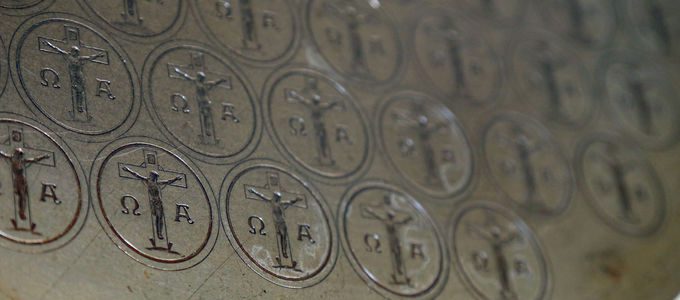
With the end of the anniversary year, our series draws to a close. Since 1919 bread and wine have been united in Holy Communion throughout the New Apostolic Church. Interesting bits and pieces in conclusion.
Fifty-fifty
This is what the congregations did during World War One out of sheer necessity. Sometimes there was so little wine that the rest of the communion cup had to be filled with water. And during the Depression the wafers even had to be halved. This was the case during a divine service conducted by Chief Apostle Helper Johann Gottfried Bischoff on 14 October 1923 in Braunschweig in Germany.
Hygienic concerns
The wine was no longer offered in a communal cup for health reasons. And introducing the practice of individual cups was out of the question for Chief Apostle Niehaus because, he said, this would bring out the social differences among the members. And dipping the wafer into the wine with a small fork or a pair of tongs also did not seem very practicable. This would in effect force the believer to “lick the soggy wafer out of his hand”—and this after shaking many hands.
Painstaking handiwork
For the first decade, the communion wafer involved a great deal of work. Not every congregation had its own stippler, which is why in many places entire families spent their Saturday sitting around a table and applying the three drops of wine with eyedroppers, syringes, or a do-it-yourself syringe made from a cork and something akin to a toothpick.
Twenty million
This was the price of one single wafer in Germany at the height of the Depression in the 1920s. Today it costs 0.6 Euro cents to produce and ship one wafer within North Rhine-Westphalia (Germany). The District Church that produces the wafers provides them free of charge for its customers.
Delivery by handcart
Helene Herterich, the manager of the church-owned communion bakery in Bielefeld (Germany), herself delivered the first package of communion wafers to the post office using a handcart. Today, of course, the shipments are picked up by a parcel service. Sometimes there are entire pallets which are then shipped across Europe by truck or overseas as airfreight.
The first customers
Paul Dach and Jacob Dietz were the first customers of the communion bakery in Bielefeld. Paul Dach was a District Apostle in North Rhine-Westphalia and received his first carton of wafers on 16 June 1931. Jacob Dietz was also a District Apostle at the same time, but in Australia. He received his shipment of wafers on 21 July 1931.
Nearly 600 kilometres high
If one were to stack all the communion wafers on top of one another that have ever been produced by the communion bakeries in Bielefeld (Germany), Cape Town (South Africa), Lusaka (Zambia, Bengaluru (India), and Buenos Aires (Argentina) the stack would be about 600 kilometres high.
Practically alcohol-free
The drops on the wafer are practically non-alcoholic. Even if pure wine were to be applied, it would amount to not more alcohol than a spoon of tomato juice contains on account of the natural fermentation process. The alcohol actually evaporates during the production process: before it is applied, the wine is boiled down over twelve hours to bring out the bright red colour better. And any alcohol that remains after that evaporates later during storage.
It all depends on the weather
How many wafers there are in a carton cannot be specified exactly: 1,600 more or less. The wafers are not counted but weighed. Humidity plays a role. The wafers have an almost unlimited shelf-life, but the bakery in Bielefeld does recommend that the contents of the cartons be used up within half a year.
Three drops of wine
The position of the three drops on the wafer is not a coincidence. Originally, an image of the crucified Christ was imprinted on the wafers. And the drops of wine were applied exactly there where the arms and legs of Jesus were attached to the cross. In 1990 this imprint was changed to the symbols Alpha and Omega. According to Revelation 22: 13 they represent the exalted Christ: “I am the Alpha and the Omega, the Beginning and the End, the First and the Last.”




